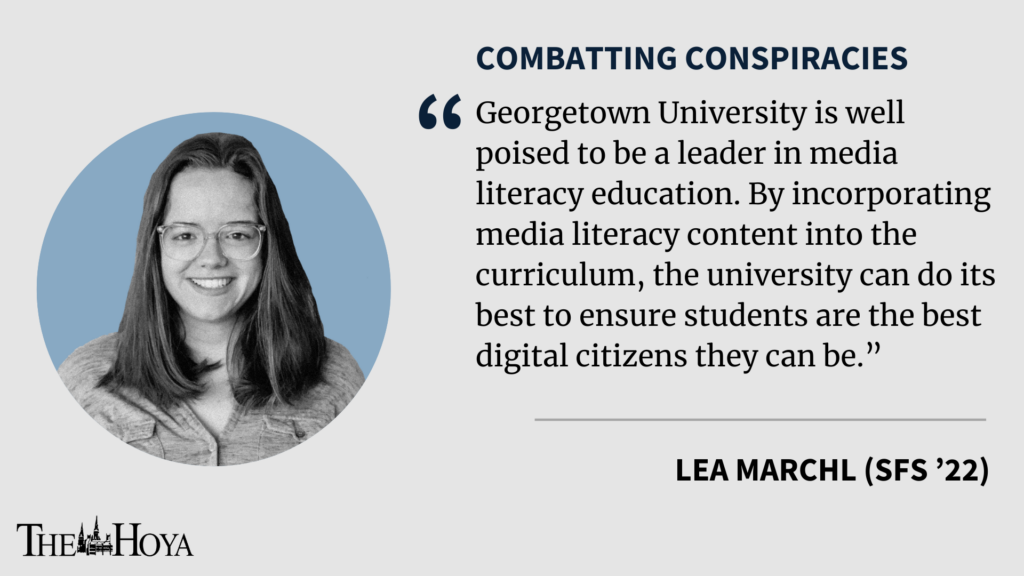When the internet became widely available, billions of people gained access to an extremely powerful tool without the necessary training to navigate it. The anonymous, monetized and viral nature of the internet makes it a cesspool for misinformation and conspiracy theories. It is perhaps no surprise countries across the world are facing information crises that threaten to seriously destabilize their societies.
In the short term, several steps can be taken to mitigate these crises. For example, Facebook has utilized artificial intelligence to flag false information and offer users more accurate content, especially related to the COVID-19 pandemic. The tactics flagged about 50 million pieces of content in April 2020 but remain a highly imperfect solution because they fail to address the problem at the root: Most people still do not know how to navigate the internet. Implementing robust programs in media literacy for both adults and children is necessary to effectively combat the spread of misinformation.
Media literacy is a tool to prepare future generations to combat the rising tide of information warfare. According to an index compiled by the Open Society Institute, the leading country in media literacy is Finland. In Finland, the local fact-checking association Fact Bar has adapted its methodologies into a curriculum for schools that includes a thorough fact-checking process that delineates disinformation, misinformation and malinformation and teaches students to differentiate between clickbait, satire, pseudoscience, conspiracy theories and other content on the internet.
Since most people think of media literacy as merely learning to read sources and fact-check, promoting internet-literate practices requires a shift in mentality. Media literacy should be thought of as a national security priority and approached in a multimodal fashion. Rather than focusing solely on consuming written information more consciously, being able to recognize doctored pictures and videos is equally important.
As it stands, the American education system does not place enough emphasis on the different ways information is circulated online. Media literacy classes often only scratch the surface of online information by focusing on written sources, as students typically use written sources to complete projects. Instead, curricula should explore the audiovisual as well, which is often where misinformation, disinformation and extremist content circulate.
Moreover, an emphasis on web design and user interface is necessary for media literacy, as it is important for people to understand content is strategically placed to attract their attention: Many social media websites are built to show content that often confirms our own biases. By implementing comprehensive media literacy education, more people will understand that algorithms often recommend heavily sensationalized and emotionally provocative content over factually accurate content.
Outside of school curricula, misinformation and disinformation can be treated as an epidemic. A number of researchers have proposed inoculation efforts for internet users: Just as inoculation to a virus is achieved through exposing an immune system to a weakened version of the virus, this proposed method shows users a weakened version of misinformation and explains how to resist that misinformation. In studies, this technique has been proven effective in countering climate change misinformation and political fake news.
Adults often hold the impression that Generation Z is well versed in how the internet functions, as we are considered digital natives. And to a certain extent, we are. Our familiarity and comfort with the internet, however, also make us susceptible to letting our guard down. Most of us never learned the actual skills necessary to think critically about every part of the web we encounter, and that must change.
Georgetown University is well poised to be a leader in media literacy education. By incorporating media literacy content into the curriculum, the university can do its best to ensure students are the best digital citizens they can be. Moreover, Georgetown can continue its partnership with local Washington, D.C. schools to develop an effective media literacy curriculum for students as young as first graders.
Implementing media literacy campaigns in education to effectively resist malicious content online is the first and most crucial step toward treating the spread of misinformation.
Lea Marchl is a junior in the School of Foreign Service. Combating Conspiracies appears online every other Friday.














